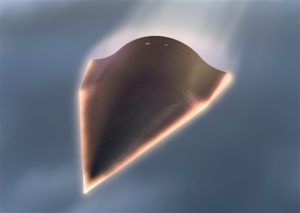
The Washington Free Beacon:
The United States is vulnerable to future attack by hypersonic missiles from China and Russia and is falling behind in the technology race to develop both defensive and offensive high-speed maneuvering arms, according to a new Air Force study.
“The People’s Republic of China and the Russian Federation are already flight-testing high-speed maneuvering weapons (HSMWs) that may endanger both forward deployed U.S. forces and even the continental United States itself,” an executive summary of the report says.
“These weapons appear to operate in regimes of speed and altitude, with maneuverability that could frustrate existing missile defense constructs and weapon capabilities.”
Hypersonic missiles are ultra-high speed weapons that travel along the edge of the earth’s atmosphere at speeds above Mach 5, or five times the speed of sound. The missiles also can maneuver to avoid current missile defenses—all of which were developed to hit ballistic missiles with predictable flight paths.
The unclassified summary of the report, “A Threat to America’s Global Vigilance, Reach, and Power: High-Speed, Maneuvering Weapons,” was produced by a blue-ribbon panel of experts for Air Force Studies Board at the National Academies of Science. The summary was made public earlier this month.
It is the first U.S. military study to sound the alarm about an arms race quietly underway for several years to develop hypersonic missiles for both strategic nuclear weapons and conventional rapid strike systems.
Mark J. Lewis, chairman of the panel that produced the report, said the panel concluded that as a result of new hypersonic missiles from Russia and China “the United States may be facing a threat from a new class of weapons that will effectively combine speed, maneuverability, and altitude in ways that could challenge this nation’s tenets of global vigilance, reach, and power.”
“Offense and defense are two sides of the same coin; as in the days of the Cold War, the only reliable deterrent to the use of a hypersonic weapon may in fact be the threat of a corresponding hypersonic countermeasure that might hold at risk the very sites from which the adversaries’ hypersonic strike would originate,” Lewis stated in a forward to the summary.
Lewis urged the U.S. government to engage in a major effort to develop both offensive and defensive means to counter high-speed maneuvering weapons. He criticized what he termed the “relatively leisurely pace of disjointed hypersonics technology development” by the Pentagon.
Additionally, foreign nuclear powers are already designing systems that exploit both the organizational disconnects and current technical limits of U.S. defenses, he said.
